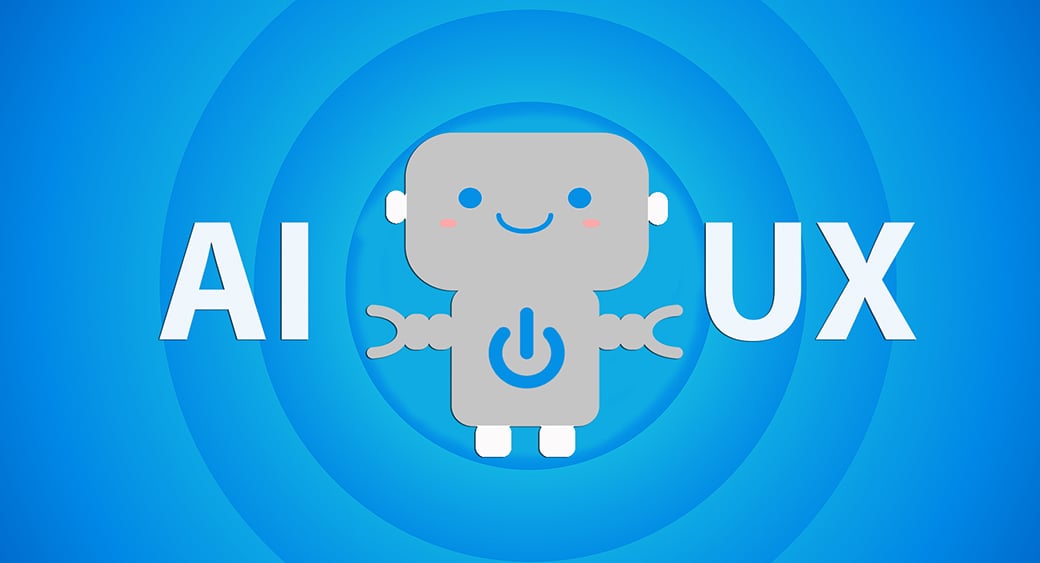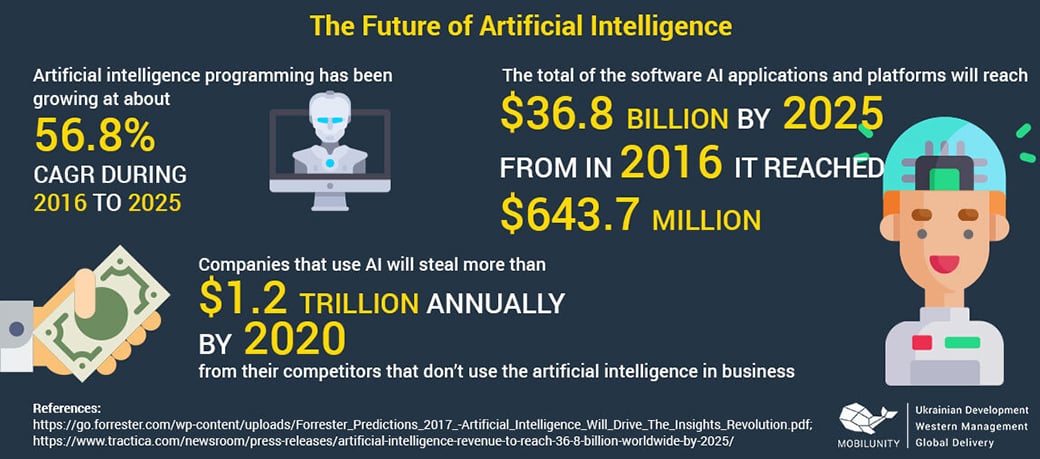Artificial Intelligence and UX – Alliance to Improve Web User Experience
Artificial intelligence is a buzzword that’s taking the technology sphere by storm, and with the hype surrounding the term, it’s easy to associate it with frenzied visions of superhuman robots ready to take over the world. In reality, though, real-world artificial intelligence and UX are much more subtle and much less terrifying. When used properly, it’s a technology that can offer substantial improvements to the human experience.

Although typical depictions of artificial intelligence and UX in popular media often involve complex physical robots that attempt to look human, AI and UX don’t have to come in such corporeal bodies, and oftentimes they don’t. The vast majority of AI and UX applications live in the confines of electronic devices such as computers and mobile phones without having a body of their own.
One particular domain that often gets overlooked by an artificial intelligence and UX developer but where the technology actually proves incredibly useful is the world wide web. Web and mobile applications serve as portals through which different companies, organizations, institutions, and even individuals can connect to the whole world. Through them, for instance, emerging businesses can gain a bigger customer base, and aspiring artists, performers, and influencers can reach wider audiences. With the web now a critical platform for discovery, communication, and collaboration, it is becoming increasingly important for web applications to deliver the best possible AI customer experience to their users. This is where a good implementation of artificial intelligence and UX can be of great help.
At the Forefront of Artificial Intelligence and UX: Machine Learning
The traditional approach for developing artificial intelligence and UX systems was to program how they should behave given particular scenarios. Among the earliest successful implementations of artificial intelligence in business environments were expert systems, which were systems that could perform problem-solving tasks in specialized areas that typically require domain experts, such as for medical diagnosis and financial advising. These systems required the assembly of a knowledge base, where all the rules and information known by actual domain experts were fed into the system in the form of if-then statements.

One problem that plagued such an artificial intelligence business solution was that they required the extraction of the complete knowledge base of the domain experts, whose time was often of high value. Moreover, every single scenario had to be covered for these systems to become robust, and large volumes of knowledge and rules meant very long development times and correspondingly high development costs.
Machine learning has emerged to solve this problem by allowing systems to learn from experience and data without having to be explicitly programmed with a single rule. This means that even if humans themselves don’t know the specific rules for performing tasks (such as, for instance, facial recognition), systems that utilize machine learning can learn these rules on their own just from previous data that show them the results of previously performed tasks. Not only does machine learning eliminate the need to extract the entire knowledge base from experts in different fields, it also makes use of machine learning algorithms that are generic enough to be used for different applications with minimal, if any, modifications. Because of this and many other benefits, machine learning has emerged as a highly popular approach for artificial intelligence and UX.
Let’s take a look at some of the ways by which a machine learning developer can utilize the technology in the domain of web development to improve the way by which AI customer experience the web.
Targeted Ads
Advertisements on websites can be annoying. Most websites display disruptive ads that are of no interest to the users, and these tend to lead them away from the site. If, however, the ads feature products or items that the user is actually currently looking for or is really interested in, there is a greater chance that the user will not only stay on the website but even click the ads or even better, eventually purchase the items being advertised. It’s really all about learning what products will be effective to advertise to each user, and machine learning can accomplish this for you.
A machine learning engineer can enable the system to learn the interests of users, their browsing behavior, the products they look for on shopping websites, the items they search and read about, or the items they regularly purchase. Websites can then utilize these data to personalize the ads they display so that only those items that are really of interest to the user get shown. This can not only increase user retention on websites, but it can also increase the click rates on the advertisements and the purchase volume for the said items. Not only can it improve the user experience of the site visitor, it also increases the effectiveness of web advertisements as a whole.
Recommendation Systems
Many of the most popular websites feature recommendation systems that suggest content for the user to explore the site. For example, every time you finish viewing a video on video-sharing websites, you’re presented with similar videos that you might also want to watch. Whenever you finish reading an article on popular blogs and news websites, you’re given links to other articles that you might also like. When you view products on online shopping websites, you are shown links to other products that you’re also likely to be looking for. These are all recommendation systems that aim to capture the interest of visitors, lengthen their stay in the site, or even increase their chances of purchasing the items being sold.

Machine learning plays a vital role in the vast majority of today’s most robust recommender systems. It enables these systems to learn the interests of each user based on the content they consume and the pages they visit in order to predict which other content they might be most interested in. When the suggested contents are tailored specifically to the interest of each individual user instead of just generic recommendations that are used for everyone, there’s a substantially greater chance that the users will actually click on these recommendations, and this ultimately increases visitor retention.
Chatbots
Chatbots are programs that aim to simulate the human ability to hold a conversation, typically through textual exchanges. The use of such chatbots by websites is becoming increasingly popular, as it’s capable of responding to user commands or inquiries and can be used to aid in such tasks as customer support, company help desk, and personal assistance. These chatbots offer many advantages over human employees: they respond and process information much faster, are able to hold multiple conversations at once and are not affected by emotions or moods. Moreover, in the long run, the use of chatbots can be more economical to the business or group that deploys it.

Chatbots make use of a field in artificial intelligence called natural language processing which enables systems to understand and process the human language as well as to generate statements that resemble human language. Machine learning offers one of the most effective approaches for natural language processing, as it enables systems to learn a language by processing large volumes of human language statements, usually in the form of text. The use of recurrent neural networks is among the machine learning methods that have proven highly effective in processing contextual data, including the human language, and it has led to increased accuracies in the performance of systems that use natural language processing. With increased chatbot performance, website visitors can rely on automated helpers that can give them just what they need and can dramatically increase customer satisfaction.
Web Security
Safety and security are among the primary concerns of both website owners and website visitors. Website owners are concerned about malicious users who intend to intrude into their systems, access private information from their databases, or carry out attacks on their servers. Website visitors, on the other hand, are concerned about websites that may spread malicious files onto their local machines and infect their systems, or that they may engage with malicious users who might scam them. So while security often gets overlooked during web development, it’s actually one of the most important components that websites should have to ensure the safety of both their servers and their users’ machines.

Machine learning can be very useful for this purpose. For example, it can be very effective for online fraud detection, where machine learning enables systems to detect which users have unnatural and suspicious behavior that tend to be associated with fraudulent intentions. This allows websites to detect and suspend users that may commit fraud against either the website administrators or other website users. Moreover, machine learning can also detect malicious users, whether human or bots, that might attempt to carry out attacks against their servers, such as denial of service attacks. Website owners can hire machine learning developers to implement such systems to their website and add an additional layer of protection that benefits them as well as their website’s visitors.
Takeaway
Artificial intelligence isn’t actually as alarming nor as threatening as it is often being portrayed to be in sci-fi movies. In reality, AI “robots” appear in much subtler forms, and most of the time we actually come across them without realizing it. When used correctly, artificial intelligence and UX can help make our lives smoother, easier, and notably more convenient.
Machine learning is a promising approach towards artificial intelligence and UX that allows machines to learn from experience just by consuming data, and it eliminates the need for explicitly programming every single behavior of an AI system. We have explored a number of artificial intelligence problems and solutions and presented some of the ways machine learning can be used to improve the user experience of both website administrators and website visitors. Soon enough, we can expect artificial intelligence and UX to introduce dramatic improvements to the human experience, both in the real world and online.




Leave a Reply